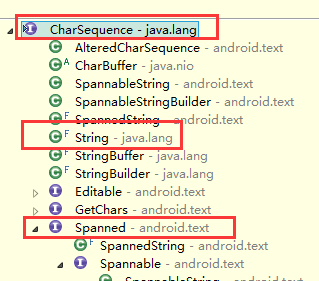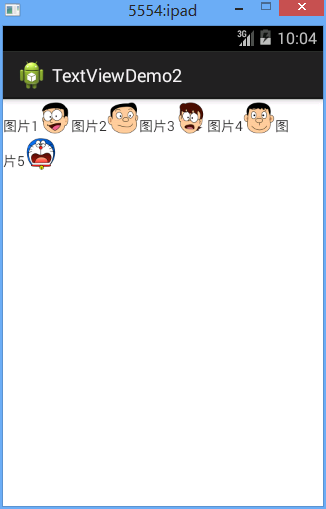TextView实现图文混合编排的方法
一、简介

在这里实现图文混合编排使用的是:TextView中预定义的类似Html的标签
二、方法
* 1、设置好html标签的文本
String html="<font>图片1</font><img src='image1'/>";
html+="<font>图片2</font><img src='image2'/>";
html+="<font>图片3</font><img src='image3'/>";
html+="<font>图片4</font><img src='image4'/>";
html+="<font>图片5</font><img src='image5'/>";
* 2、为之前的文本声明Html.fromHtml,方便TextView解析为html标签
tv_one.setText(Html.fromHtml(text1));
因为有图片,我们要获取图片源,所以上面的那句不行;
所以如下:
CharSequence text=Html.fromHtml(html, new ImageGetter() {中间省略}, null);
new ImageGetter() {中间省略}这部分比较复杂,看实例代码吧,实质就是取到R文件中图片对应的ID
* 3、将CharSequence字符串序列的文本text插入到TextView控件中即可
tv_textAndImage.setText(text);
这里是charSequence是因为Html.fromHtml方法的返回值是Spanned类型,
看下下面的类图特别好懂:

三、代码实例
效果图

代码
fry.ActivityDemo2
package fry;
import java.lang.reflect.Field;
import com.example.textViewDemo1.R;
import android.app.Activity;
import android.graphics.drawable.Drawable;
import android.os.Bundle;
import android.text.Html;
import android.text.Html.ImageGetter;
import android.widget.TextView;
public class ActivityDemo2 extends Activity{
private TextView tv_textAndImage;
@Override
protected void onCreate(Bundle savedInstanceState) {
// TODO Auto-generated method stub
super.onCreate(savedInstanceState);
setContentView(R.layout.activity02);
setTitle("TextViewDemo2");
tv_textAndImage=(TextView) findViewById(R.id.tv_textAndImage);
//第一步,设置文本
String html="<font>图片1</font><img src='image1'/>";
html+="<font>图片2</font><img src='image2'/>";
html+="<font>图片3</font><img src='image3'/>";
html+="<font>图片4</font><img src='image4'/>";
html+="<font>图片5</font><img src='image5'/>";
//第二步,告诉TextView控件这是html,并且获取文本中的图片源
CharSequence text=Html.fromHtml(html, new ImageGetter() {
public Drawable getDrawable(String source) {
// TODO Auto-generated method stub
//根据图片资源ID获取图片
//getResources就是去找项目里面的res文件夹
Drawable drawable=getResources().getDrawable(getDrawableResurceID(source));
//一定要加上边界这部分代码。要不然drawable会因为信息不完整读不出来图片
//分别是left top width height
drawable.setBounds(0, 0, drawable.getIntrinsicWidth(), drawable.getIntrinsicHeight());
return drawable;
}
}, null);
//第三步、将CharSequence字符串序列的文本text插入到TextView控件中即可
tv_textAndImage.setText(text);
}
/**
* 获取图片的资源ID
* @param imageName 图片的名称
* @return 图片对应的ID
*
*/
private int getDrawableResurceID(String imageName){
//利用反射机制取得图片的id
/*
* 其实是找com.example.textViewDemo1.R.drawable.image1的值,也就是
* public static final int image1=0x7f020001;
* 也就是0x7f020001
* 例如image1,返回的就是0x7f020001
*/
try {
Field field=R.drawable.class.getField(imageName);
return Integer.parseInt(field.get(null).toString());
} catch (Exception e) {
// TODO Auto-generated catch block
e.printStackTrace();
}
return 0;
}
}
/textViewDemo1/res/layout/activity02.xml
<?xml version="1.0" encoding="utf-8"?>
<LinearLayout xmlns:android="http://schemas.android.com/apk/res/android"
android:layout_width="match_parent"
android:layout_height="match_parent"
android:orientation="vertical" >
<TextView
android:id="@+id/tv_textAndImage"
android:layout_width="match_parent"
android:layout_height="wrap_content"
/>
</LinearLayout>
以上就是本文的全部内容,希望对大家的学习有所帮助,也希望大家多多支持我们。

